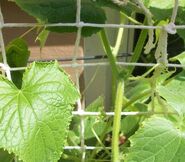| Cucumber | |
|---|---|
 | |
| Scientific classification | |
| Kingdom | Plantae |
| Subkingdom | Tracheobionta |
| Superdivision | Spermatophyta |
| Division | Magnoliophyta |
| Class | Magnoliopsida |
| Subclass | Dilleniidae |
| Order | Violales |
| Family | Cucurbitaceae |
| Genus | Cucumis L. |
| Species | Cucumis sativus L. |
The cucumber (Cucumis sativus) is a widely cultivated plant in the gourd family Cucurbitaceae, which includes squash, and in the same genus as the muskmelon. The plant is a creeping vine which bears cylindrical edible fruit when ripe. There are three main varieties of cucumber: "slicing", "pickling", and "burpless". Within these varieties, several different cultivars have emerged. The cucumber is originally from India but is now grown on most continents. Many different varieties are traded on the global market.
Description[]
The cucumber is a creeping vine that roots in the ground and grows up trellises or other supporting frames, wrapping around supports with thin, spiraling tendrils. The plant has large leaves that form a canopy over the fruit. The fruit of the cucumber is roughly cylindrical, elongated with tapered ends, and may be as large as Template:Convert long and Template:Convert in diameter. Having an enclosed seed and developing from a flower, botanically speaking, cucumbers are classified as fruits. However, much like tomatoes and squash they are often perceived, prepared and eaten as vegetables. Cucumbers are usually more than 90% water.
Flowering and pollination[]
A few varieties of cucumber are parthenocarpic, the blossoms creating seedless fruit without pollination. Pollination for these varieties degrades the quality. In the United States, these are usually grown in greenhouses, where bees are excluded. In Europe, they are grown outdoors in some regions, and bees are excluded from these areas. Most cucumber varieties, however, are seeded and require pollination. Thousands of hives of honey bees are annually carried to cucumber fields just before bloom for this purpose. Cucumbers may also be pollinated by bumblebees and several other bee species.
Symptoms of inadequate pollination include fruit abortion and misshapen fruit. Partially pollinated flowers may develop fruit which are green and develop normally near the stem end, but pale yellow and withered at the blossom end.
Traditional varieties produce male blossoms first, then female, in about equivalent numbers. New gynoecious hybrid cultivars produce almost all female blossoms. However, since these varieties do not provide pollen, they must have interplanted a pollenizer variety and the number of beehives per unit area is increased. Insecticide applications for insect pests must be done very carefully to avoid killing off the insect pollinators.

Cucumber and cross section
Template:Clear-left
Genome[]
In 2009, an international team of researchers announced they had sequenced the cucumber genome.
Distribution and habitat[]
According to the Food and Agriculture Organization of the United Nations, China produced at least 60% of the global output of cucumber and gherkin in 2005, followed at a distance by Turkey, Russia, Iran and the United States.
Production[]
| Top ten cucumber producers in 2010 | ||||
|---|---|---|---|---|
| Country | Production (tonnes) | |||
| China | 40,709,556 | |||
| Iran | 1,811,630 | |||
| Turkey | 1,739,190 | |||
| Russia | 1,161,870 | |||
| United States | 883,360 | |||
| Ukraine | 860,100 | |||
| Spain | 682,900 | |||
| Egypt | 631,408 | |||
| Japan | 587,800 | |||
| Indonesia | 547,141 | |||
| World | 57,559,836 | |||
| Source: UN Food & Agriculture Organisation (FAO) | ||||
Cultivation[]
History[]
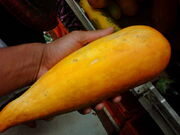
An Indian yellow cucumber
Cucumbers originated in India. It has been cultivated for at least 3,000 years, and was probably introduced to other parts of Europe by the Greeks or Romans. Records of cucumber cultivation appear in France in the 9th century, England in the 14th century, and in North America by the mid-16th century.
Earliest cultivation[]
The cucumber is listed among the foods of ancient Ur, and the legend of Gilgamesh describes people eating cucumbers. Some sources also state it was produced in ancient Thrace, and it is certainly part of modern cuisine in Bulgaria and Turkey, parts of which make up that ancient state. From India, it spread to Greece (where it was called "σίκυον", síkyon) and Italy (where the Romans were especially fond of the crop), and later into China.
According to Pliny the Elder (The Natural History, Book XIX, Chapter 23), the Ancient Greeks grew cucumbers, and there were different varieties in Italy, Africa, and modern-day Serbia.
Roman Empire[]
According to Pliny, the Emperor Tiberius had the cucumber on his table daily during summer and winter. The Romans reportedly used artificial methods (similar to the greenhouse system) of growing to have it available for his table every day of the year. "Indeed, he was never without it; for he had raised beds made in frames upon wheels, by means of which the cucumbers were moved and exposed to the full heat of the sun; while, in winter, they were withdrawn, and placed under the protection of frames glazed with mirrorstone. Reportedly, they were also cultivated in cucumber houses glazed with oiled cloth known as “specularia”.
Pliny the Elder describes the Italian fruit as very small, probably like a gherkin, describing it as a wild cucumber considerably smaller than the cultivated one. Pliny also describes the preparation of a medication known as elaterium, though some scholars believe he was referring to Cucumis silvestris asininus, a species different from the common cucumber. Pliny also writes about several other varieties of cucumber, including the cultivated cucumber, and remedies from the different types (9 from the cultivated, 5 from the "anguine", and 26 from the "wild"). The Romans are reported to have used cucumbers to treat scorpion bites, bad eyesight, and to scare away mice. Wives wishing for children wore them around their waists. They were also carried by the midwives, and thrown away when the child was born.
Middle Ages[]
Charlemagne had cucumbers grown in his gardens in 9th Century France. They were reportedly introduced into England in the early 14th century, lost, then reintroduced approximately 250 years later. The Spaniards (through the Italian Christopher Columbus) brought cucumbers to Haiti in 1494. In 1535, Jacques Cartier, a French explorer, found “very great cucumbers” grown on the site of what is now Montreal.
Post-enlightenment[]
Throughout the 16th century, European trappers, traders, bison hunters, and explorers bartered for the products of American Indian agriculture. The tribes of the Great Plains and the Rocky Mountains learned from the Spanish how to grow European crops. The best farmers on the Great Plains were the Mandan Indians in what is now North and South Dakota. They obtained cucumbers and watermelons from the Spanish, and added them to the crops they were already growing, including several varieties of corn and beans, pumpkins, squash, and gourd plants. The Iroquois were also growing them when the first Europeans visited them.
In 1630, the Reverend Francis Higginson produced a book called New England’s Plantation in which, describing a garden on Conant’s Island in Boston Harbor known as “The Governor’s Garden”, he states: “The countrie aboundeth naturally with store of roots of great varietie and good to eat. Our turnips, parsnips, and carrots are here both bigger and sweeter than is ordinary to be found in England. Here are store of pompions, cowcumbers, and other things of that nature which I know not...”
William Wood also published in 1633’s New England Prospect (published in England) observations he made in 1629 in America: “The ground affords very good kitchin gardens, for Turneps, Parsnips, Carrots, Radishes, and Pompions, Muskmillons, Isquoter-squashes, coucumbars, Onyons, and whatever grows well in England grows as well there, many things being better and larger.”
In the later 17th century, a prejudice developed against uncooked vegetables and fruits. A number of articles in contemporary health publications stated that uncooked plants brought on summer diseases and should be forbidden to children. The cucumber kept this vile reputation for an inordinate period of time: “fit only for consumption by cows”, which some believe is why it gained the name, “cowcumber”.
A copper etching made by Maddalena Bouchard between 1772 and 1793 shows this plant to have smaller, almost bean-shaped fruits, and small yellow flowers. The small form of the cucumber is figured in Herbals of the 16th century, but states, ‘if hung in a tube while in blossom, the Cucumber will grow to a most surprising length.’
Samuel Pepys wrote in his diary on September 22, 1663: “this day Sir W. Batten tells me that Mr. Newhouse is dead of eating cowcumbers, of which the other day I heard of another, I think.” In "The Greenstone Door", William Satchell notes that "Te Moanaroa was dead - of a surfeit of cucumbers...", having eaten four of the "prickly" melons. (Chapter XX, The Storm Cloud).
Fredric Hasselquist, in his travels in Asia Minor, Egypt, Cyprus and Palestine in the 18th century, came across the Egyptian or hairy cucumber, Cucumis chate. It is said by Hasselquist to be the “queen of cucumbers, refreshing, sweet, solid, and wholesome.” He also states “they still form a great part of the food of the lower-class people in Egypt serving them for meat, drink and physic.” George E. Post, in Hastings' Dictionary of the Bible, states, “It is longer and more slender than the common cucumber, being often more than a foot long, and sometimes less than an inch thick, and pointed at both ends.”
Varieties[]
In human cultivation, the varieties of cucumbers are classified into three main varieties: "slicing", "pickling", and "burpless".
Slicing[]
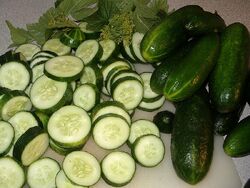
Slicing cucumbers
Cucumbers which are grown to be eaten fresh are called slicing cucumbers. They are mainly eaten in the unripe, green form. The ripe, yellow form normally becomes bitter and sour. Slicers grown commercially for the North American market are generally longer, smoother, more uniform in color, and have a much tougher skin. Slicers in other countries are smaller and have a thinner, more delicate skin. Smaller slicing cucumbers can also be pickled.
Pickling[]
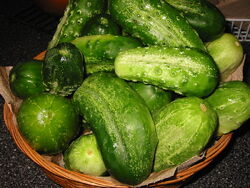
Pickling cucumbers
- Main article: Pickled cucumber
Cucumbers can be pickled for flavor and longer shelf-life. Although any cucumber can be pickled, commercial pickles are made from cucumbers specially bred for uniformity of length-to-diameter ratio and lack of voids in the flesh. Those cucumbers intended for pickling, called picklers, grow to about Template:Convert to Template:Convert long and Template:Convert wide. As compared to slicers, picklers tend to be shorter, thicker, less regularly shaped, and have bumpy skin with tiny white or black-dotted spines. They are never waxed. Color can vary from creamy yellow to pale or dark green. Pickling cucumbers are sometimes sold fresh as “Kirby” or “Liberty” cucumbers. The pickling process removes or degrades much of the nutrient content, especially that of vitamin C. Pickled cucumbers are soaked in brine or a combination of vinegar and brine, although not vinegar alone, often along with various spices. Pickled cucumbers are called "pickles" in the US or "gherkins" or "wallies" in the UK, the latter name being more common in the north of England, where it refers to the large vinegar-pickled cucumbers commonly sold in fish and chip shops. (Although the gherkin is of the same species as the cucumber, it is of a completely different cultivar.)
English[]
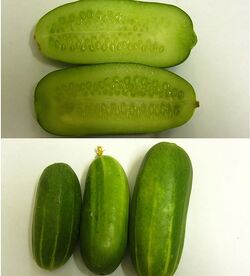
Isfahan burpless cucumber originally from Dastgerd khiyar
English cucumbers are sweeter and have a thinner skin than other varieties of cucumber, and are reputed to be easy to digest and to have a pleasant taste. They can grow as long as . They are nearly seedless, and have a delicate skin which is pleasant to eat. Most commonly grown in greenhouses, these parthenocarpic cucumbers are often found in grocery markets, shrink-wrapped in plastic. They are sometimes marketed as seedless or burpless, because the seeds and skin of other varieties of cucumbers are said to give some people gas.
Several varietals exist and are sold commercially:
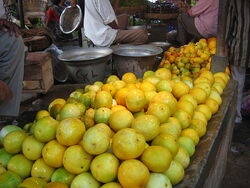
Dosakai is a round, yellow, cucumber seen here at a market in Guntur, India
- Lebanese cucumbers are small, smooth-skinned and mild. Like the English cucumber, Lebanese cucumbers are nearly seedless.
- East Asian cucumbers are mild, slender, deep green, and have a bumpy, ridged skin. They can be used for slicing, salads, pickling, etc., and are available year-round. They are usually burpless as well.
- Armenian cucumbers (also known as yard long) have very long, ribbed fruit with a thin skin that does not require peeling, but are actually an immature melon. This is the variety sold in Middle Eastern markets as "pickled wild cucumber". In North America, the term “wild cucumber” refers to manroot.
- Persian cucumber, better known as mini seedless cucumbers, are available from Canada during the summer, and all year-round in the US. Its popularity is increasing 30 to 40% a year. Easy to cut, it is on average 5-8 in. long. Vines are parthenocarpic, requiring no pollinators for fruit set.
- Beit Alpha cucumbers are small, sweet parthenocarpic cucumbers adapted to the dry climate of the Middle East.
- Apple cucumbers are short, round cucumbers grown in New Zealand and parts of Europe, known for their light yellow-green color and mildly sweet flavor. When mature, the fruit may grow tiny spines, and contains numerous edible green seeds. The fruit is usually eaten raw, with skin.
- Dosakai is a yellow cucumber available in parts of India. These fruits are generally spherical in shape. It is commonly cooked as curry, added in sambar or soup, daal and also in making dosa-aavakaaya (Indian pickle) and chutney; it is also grown and available through farms in Central California.
- Kekiri is a smooth skinned cucumber, relatively hard, and not used for salads. It is cooked as spicy curry. It is found in dry zone of Sri Lanka. It becomes orange colored when the fruit is matured.
- In May 2008, British supermarket chain Sainsbury's unveiled the 'c-thru- cumber', a thin-skinned variety which reportedly does not require peeling.
Taste[]
There appears to be variability in the human olfactory response to cucumbers, with the majority of people reporting a mild, almost watery flavor or a light melon taste, while a small but vocal minority report a highly repugnant taste, some say almost perfume-like.
There are several ways to remove bitterness from cucumbers. One way used in India, includes slicing off the ends of a cucumber, sprinkling some salt, and rubbing the now-exposed ends of said cucumber with the sliced-off ends until it appears to froth. Another such urban legend states that one ought to peel a cucumber away from the end that was once attached to a vine, otherwise one risked spreading the bitterness throughout the cucumber.
Storage[]
Cucumbers can best be stored sealed in shrink foil. Sealing a cucumber increases its shelf life considerably.
Farming methods[]
The usual commercial method of cultivating cucumbers involves the use of mineral (manufactured) fertilizer.
In the news[]
In May 2011, cucumbers infected with E. coli were claimed to have caused the deaths of at least ten people, leading to some retailers withdrawing cucumbers from sale in Germany, Austria and the Czech Republic. The cucumbers were initially thought to have been sourced from Spain, however subsequent test failed to show contamination in the imported Spanish cucumbers which led to the Spanish Government demanding compensation for Spanish farmers who had been forced to destroy huge quantities of cucumbers.
After the outbreak, the World Health Organization stated that it was a completely new strain of the bacteria involved.
Gallery[]
References[]

|
This page uses content from Wikipedia. The original article was at Cucumber. The list of authors can be seen in the page history. As with Horticulture and Soil Science Wiki, the text of Wikipedia is available under the Creative Commons Licence. |
External links[]
- Plant profile at the Plants Database - shows classification and distribution by US state.
- The Art of Promoting the Growth of the Cucumber and Melon by Thomas Watkins
- Cucumber Nutrition Information from USDA SR22 database

